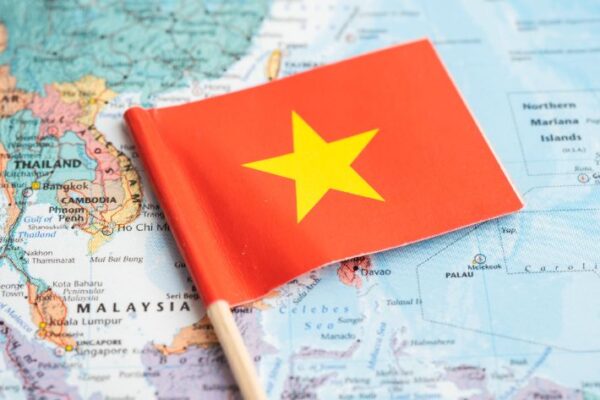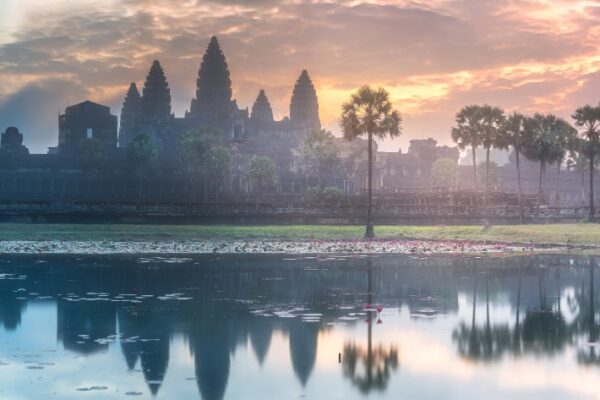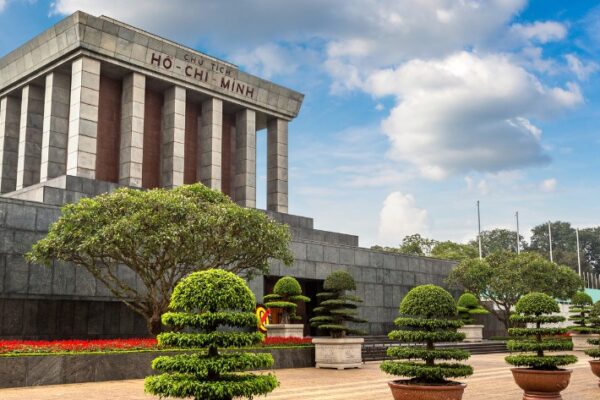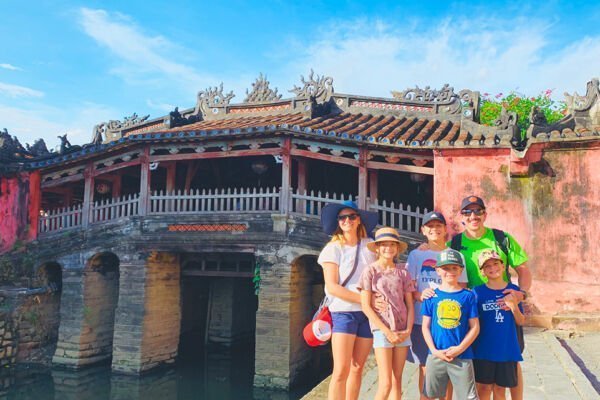Vietnam War Locations: Walking Through 12 Historic Sites Across Three Regions
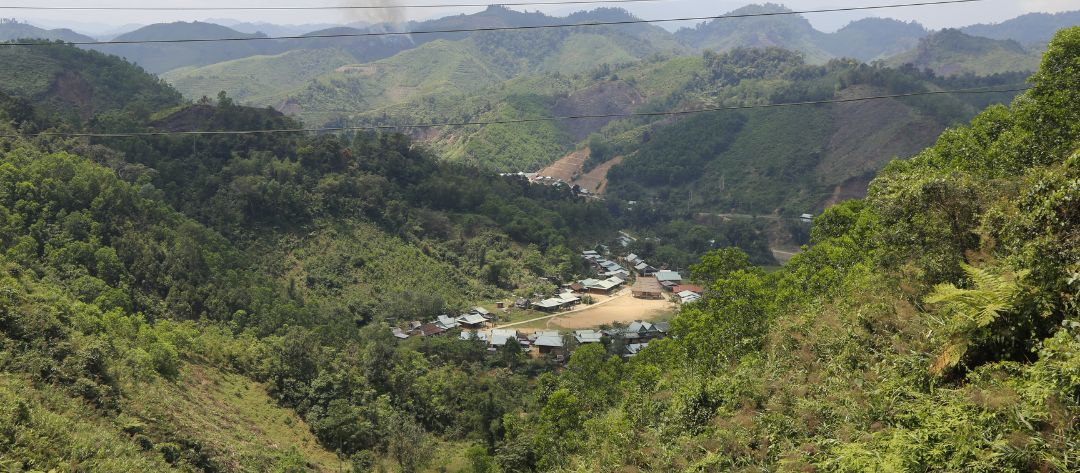
Not only does Vietnam captivate with its stunning landscapes, but it also enchants through the depth of its history and culture. This guide will take you through 12 Vietnam war locations where history remains tangible, all of which will leave you with a deeper understanding of this country beyond its beauty.
Exploring Vietnam War Locations: Unique Experiences
- Connect with Vietnam’s heritage through preserved battlefields, memorials, and museums
Exploring Vietnam’s war heritage is not only about looking back—it is about stepping into a living dialogue between past and present. Walking through Vietnam war locations like preserved battlefields, pausing at solemn memorials, or wandering museum halls brings history out of the abstract and into the senses.
The silence of a monument, the worn earth of an old combat zone, or the haunting images displayed on museum walls remind travelers that culture is shaped as much by resilience as by celebration. These sites become gateways, offering an intimate glimpse into how Vietnam remembers, heals, and carries its story forward.
- Understanding history opens richer conversations with locals and guides
Travel becomes more meaningful when history is part of the journey. Knowledge of what happened in these Vietnam war locations allows conversations with locals and guides to move beyond pleasantries. Stories of endurance, loss, and renewal often surface when visitors show genuine curiosity.
A guide may share a family memory, or a local may reveal how traditions grew stronger in the aftermath of conflict. These exchanges are not scripted—they are heartfelt connections sparked by understanding. In this way, historical awareness deepens the travel experience, turning encounters into shared reflections rather than fleeting moments.
- Learn how to navigate emotionally charged sites without causing offense
Vietnam war locations carry emotions that are still alive in memory. Entering them with quiet respect honors those who lived through unimaginable times. A thoughtful traveler notices when to speak and when silence feels more fitting, when to take a photo and when to simply observe. These gestures, though subtle, preserve the dignity of the spaces.
By showing awareness and sensitivity, visitors not only avoid giving offense but also create room for reflection—for themselves and for those who still hold these places close to their hearts. In that calm respect, travel becomes something more: an act of remembrance and empathy.
>> Discover More: Top 10 Indochina War Sites Every History Traveler Must Visit
Vietnam War Site Essentials: 12 Locations by Region
Northern Vietnam
Hoa Lo Prison
- Location: 01 Hoa Lo Street, Hoan Kiem District, Hanoi
In the heart of Hanoi, the weathered gates of Hoa Lo Prison stand as a stark reminder of Vietnam’s layered history. First built by the French to confine Vietnamese political prisoners, its walls later became infamous during the Vietnam War, when captured American pilots were held here under the name “Hanoi Hilton”.
Stepping inside, the silence is heavy. A guillotine chamber recalls the colonial era, while narrow cells—with concrete beds, ankle shackles, and tiny barred windows—show the harshness of daily confinement. The site embodies more than just stone and iron; it carries the weight of both oppression and endurance, revealing how generations lived through, resisted, and bore the struggles of their time.
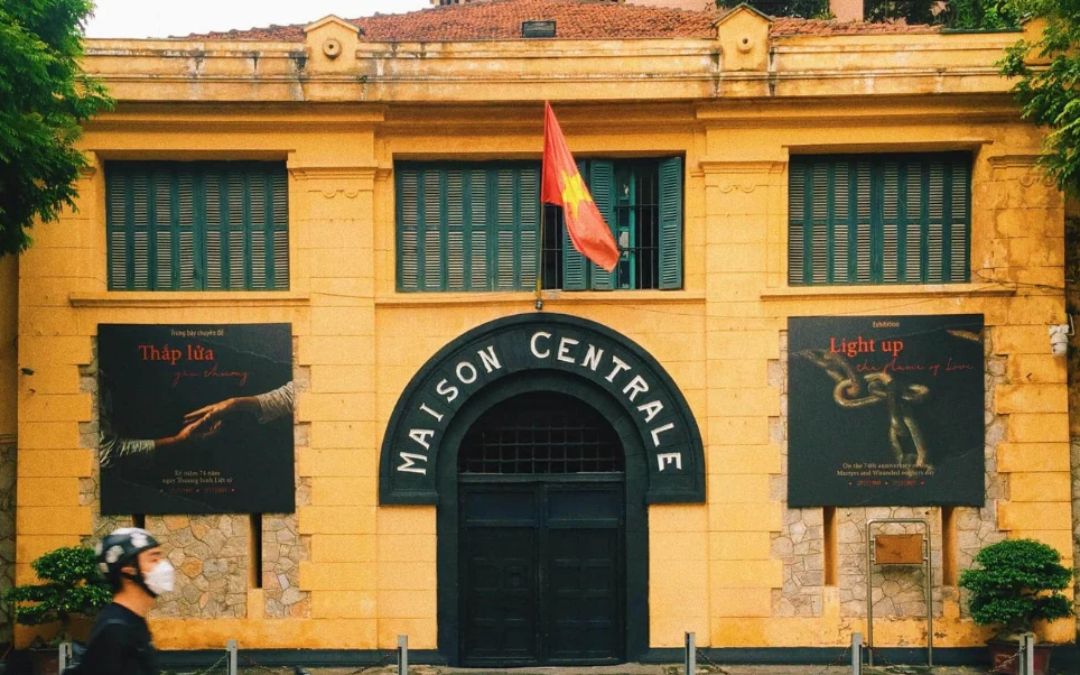
Hoa Lo Prison stands as one of the most historically significant Vietnam war locations in Hanoi’s heart.
Vietnam Military History Museum
- Location: 28A Dien Bien Phu Street, Ba Dinh District, Hanoi
Just a short walk from the Presidential Palace, the Vietnam Military History Museum offers a sweeping journey through centuries of conflict and resilience. Founded in 1956 and relocated to a striking new space in 2024, the museum blends sleek modern architecture with immersive storytelling.
Inside, galleries lead visitors through Vietnam’s long martial history—early state formation, wars against French and American forces, reunification, and beyond. Outside, the grounds feel alive with relics of battle: MiG-21 fighter jets, the T-54B tank that crashed through the gates of Saigon’s Independence Palace, and the twisted remains of a downed B-52 bomber.
Interactive exhibits—VR battle simulations, AR reconstructions, and 3D strategic maps—invite not only observation but participation, letting history unfold in more than words or images. It’s a place where memory and modern technology meet, making the past something to experience with all the senses.

The Vietnam Military History Museum showcases an impressive collection of wartime artifacts and military equipment.
>> Discover More: How to Make the Most out of One Week in Hanoi?
Dien Bien Phu Battlefield
- Location: Vo Nguyen Giap Street, Dien Bien Phu City, Dien Bien Province
Far in the northwest, beyond Hanoi’s restless pace, lies Dien Bien Phu—a valley that shifted the destiny of a nation. Here in 1954, Viet Minh forces surrounded a heavily fortified French camp, digging trenches, carving artillery posts into the mountains, and enduring a grueling two-month siege. When the French surrendered, colonial rule in Indochina came to an end, and the course of Southeast Asia was forever changed.
Today, the valley remains one of the most significant Vietnam war locations scarred with history. Bunkers and trenches still trace the ground, while the road through Pha Din Pass—once a vital lifeline for supplies—is now a peaceful stretch of winding beauty.
Visitors can step into the De Castries bunker, stand before the solemn martyrs’ cemetery, or simply look across the quiet landscape and imagine how resilience turned into victory. In this stillness, the echoes of determination feel unmistakably alive.

Dien Bien Phu Battlefield remains one of the most pivotal Vietnam war locations that changed Southeast Asian history.
Son La Prison
- Location: Son La Town, Son La Province
Son La Prison, built by the French in 1908 in Son La Province, was designed to detain Vietnamese patriots and political prisoners. At its peak, it held more than 500 revolutionaries in harsh conditions, with overcrowded stone cells, chains, and malnutrition used to break their spirit. Many prominent figures were imprisoned here, including To Hieu, whose leadership and courage inspired fellow inmates.
Today, the prison ruins remain a historic site, where visitors can see the watchtowers, solitary cells, and the peach tree planted by To Hieu that still blossoms as a symbol of resilience. Preserved exhibits and memorials offer a powerful glimpse into Vietnam’s fight for independence, making the site both a solemn reminder of sacrifice and a place of national pride.

Son La Prison represents one of the lesser-known Vietnam war locations that witnessed countless stories of endurance.
Central Vietnam & the DMZ
Khe Sanh Combat Base
- Location: Huong Hoa District, Quang Tri Province
The wind moves quietly across the hills where Khe Sanh Combat Base once stood, near the old Demilitarized Zone. Between 1962 and 1975, this Marine Corps outpost was the scene of fierce battles, most famously during the Tet Offensive of 1968.
What remains today are bunkers, a long airstrip, and rusting helicopters, their metal frames scarred by time. Standing among them, it’s easy to picture the chaos of supply runs and the long weeks of siege.
The grasses grow thick now, wrapping around C-130s, Chinooks, and Huey helicopters, as if nature itself is slowly closing the chapter. Yet every artifact still carries a quiet voice—reminders of strategy, hardship, and endurance.
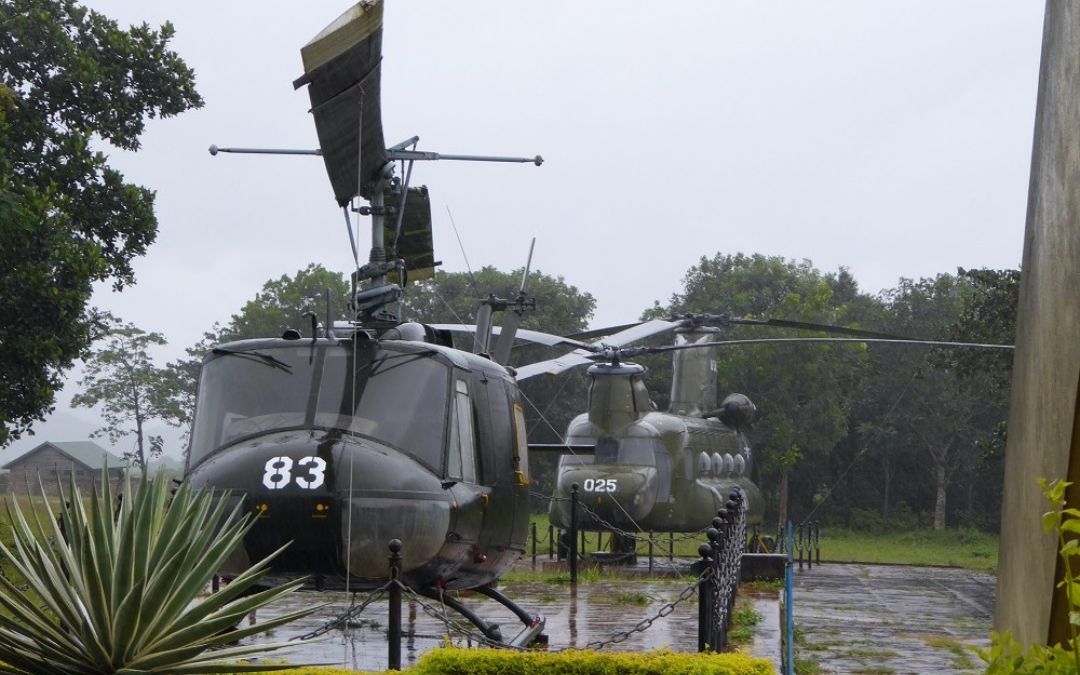
Vietnam war locations like Khe Sanh Combat Base preserve the remnants of intense battles fought near the DMZ.
Vinh Moc Tunnels
- Location: Vinh Moc Village, Vinh Linh District, Quang Tri Province
Step into the earth at Vinh Moc, where nearly two kilometers of tunnels tell the story of survival and hope. During the heaviest bombing campaigns, villagers here carved three underground levels to protect themselves—complete with kitchens, wells, clinics, and even a small maternity ward. Thirteen entrances connect the tunnels to both hillside and sea, doubling as pathways for air and escape.
Life did not just hide here—it continued. Around 60 families lived underground, and 17 babies were born in safety during those years, with no lives lost.
Walking through the cool stone walls today, the air feels heavy with both courage and resilience. It is a place where hardship met creativity, and where the community kept its heart alive below the surface.

The Vinh Moc Tunnels showcase the ingenuity found in many Vietnam war locations where communities survived underground.
Son My Memorial
- Location: Tinh Khe Village, Son Tinh District, Quang Ngai Province
The My Lai site, now known as the Son My Vestige Site, is not simply a place—it is an experience of remembrance. Broken foundations of village homes mark where tragedy struck in 1968, and plaques honor the lives that ended too soon.
At the center, a towering sculpture of a grieving mother holds her lifeless child, a powerful symbol of loss that no words can soften. Nearby, the small museum holds photographs, objects, and testimonies that bring the event into sharp human focus. This is more than history on display; it is a space that invites reflection, where silence becomes an act of respect, and every step is a reminder of the heavy cost of conflict.

Son My Memorial serves as one of the most solemn Vietnam war locations dedicated to remembrance and reflection.
Hien Luong Bridge
- Location: Hien Luong Village, Vinh Linh District, Quang Tri
Crossing the Hien Luong Bridge is like stepping into a memory of division. This bridge, spanning the Ben Hai River, once marked the 17th Parallel—the line separating North and South Vietnam. Painted in two distinct colors, each side represented its own vision of the future, while loudspeakers from both banks shouted competing messages across the water. Though rebuilt over the decades, the bridge is now a quiet pedestrian crossing, its boards carrying far gentler footsteps.
Here, visitors can pause to imagine a time when paint, sound, and steel carried the weight of two nations at odds. Standing in the middle, the river below calm and still, the bridge feels less like a scar and more like a symbol of reconciliation.
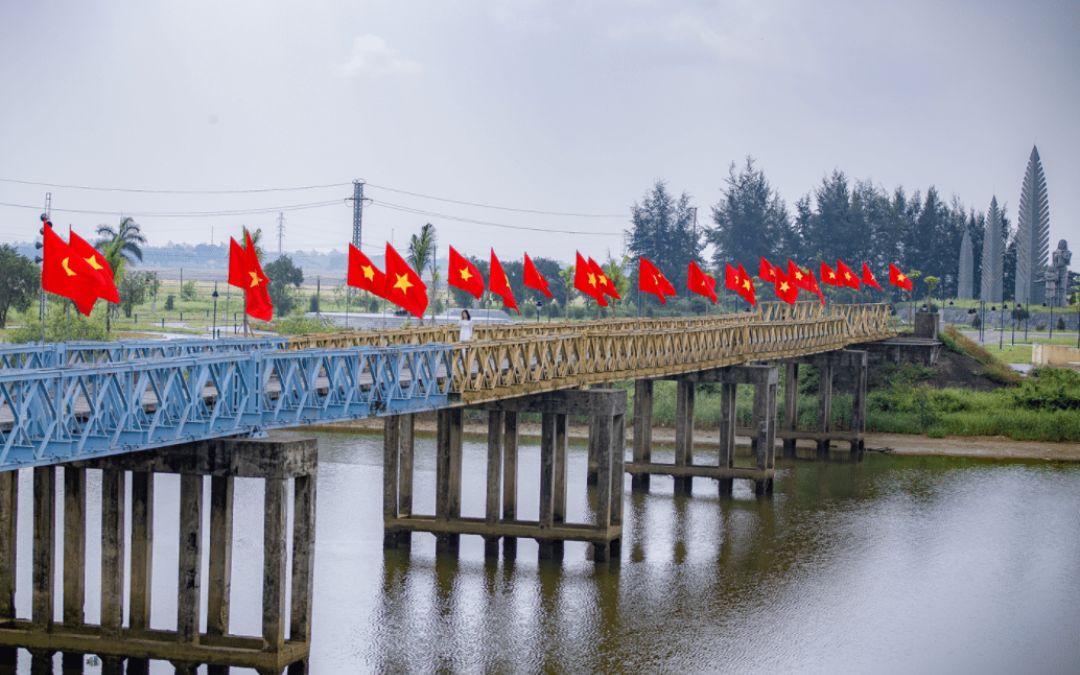
Historical significance marks Hien Luong Bridge as one of the most symbolic Vietnam war locations representing division and unity.
Southern Vietnam
Cu Chi Tunnels
- Location: Phu Hiep Ward, Cu Chi District, Ho Chi Minh City
Stepping down into the Cu Chi Tunnels feels like entering another world—one carved from earth, survival, and determination. These underground passageways, stretching over 250 kilometers from the fringes of Saigon toward the Cambodian border, served as vital lifelines for Viet Cong fighters.
Here, everyday life happened in darkness: kitchens, hospitals, even schools carved into the earth, lit by the faint glow of candle or flashlight. Ingenious defenses—bamboo spikes, concealed booby traps—revealed a creativity as sharp as it was relentless.
Despite relentless campaigns like Operations Crimp and Cedar Falls, when U.S. forces unleashed B-52 bombing raids and chemical defoliants, the tunnels endured. Repaired, expanded, and adapted, they became not just a network but a symbol of resilience that refused to vanish.

Cu Chi Tunnels rank among the most famous Vietnam War locations, demonstrating underground warfare tactics and survival strategies.
War Remnants Museum
- Location: 28 Vo Van Tan Street, District 3, Ho Chi Minh City
A visit to the War Remnants Museum in Ho Chi Minh City is as much a journey inward as it is through history.
Outside, the courtyard brims with silent giants of war: UH-1 “Huey” helicopters, artillery, and rusted tanks. Inside, the mood shifts. Photographs line the walls—raw, unflinching images of Agent Orange’s devastation. Exhibits display preserved artifacts and testimony that bear witness to tragedies such as the My Lai massacre. Captions in Vietnamese, English, and Japanese guide visitors gently but firmly through these accounts.
Permanent and rotating galleries speak not of battles alone but of wounds etched into memory, body, and society itself. Each room asks for quiet reflection, making this museum less a collection of objects than a confrontation with the cost of conflict.
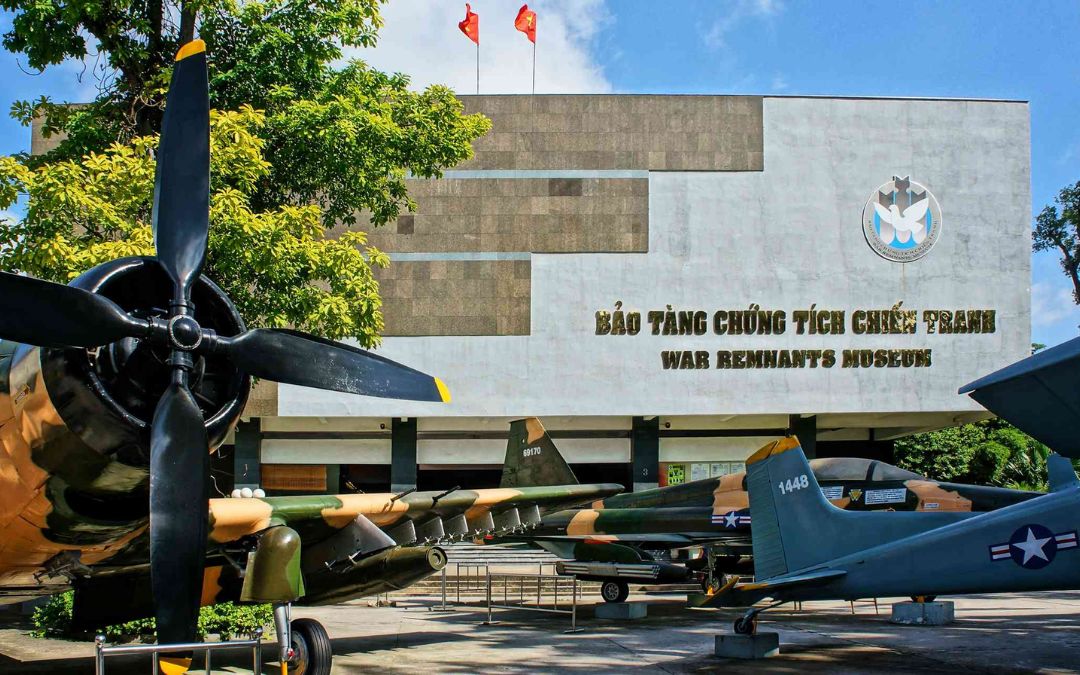
War Remnants Museum stands out among Vietnam war locations for its comprehensive documentation of conflict’s lasting impact.
Reunification Palace
- Location: 135 Nam Ky Khoi Nghia Street, District 1, Ho Chi Minh City
Rising with a modernist Vietnamese façade, the Reunification Palace—once known as Independence Palace—still carries the weight of one of history’s decisive days. Completed in 1966 as the official residence and working headquarters of South Vietnam’s leadership, it became the stage for the conflict’s dramatic conclusion.
On April 30, 1975, a North Vietnamese tank smashed through its gates, signaling the war’s end and the collapse of division. Walking its halls today feels like moving through a time capsule: maps still cover command room walls, banquet halls stand preserved, and bullet scars remain etched into doors and corridors. As both a museum and a working convention center, the palace offers a rare pause between past and present, allowing visitors to stand in the very rooms where history shifted.
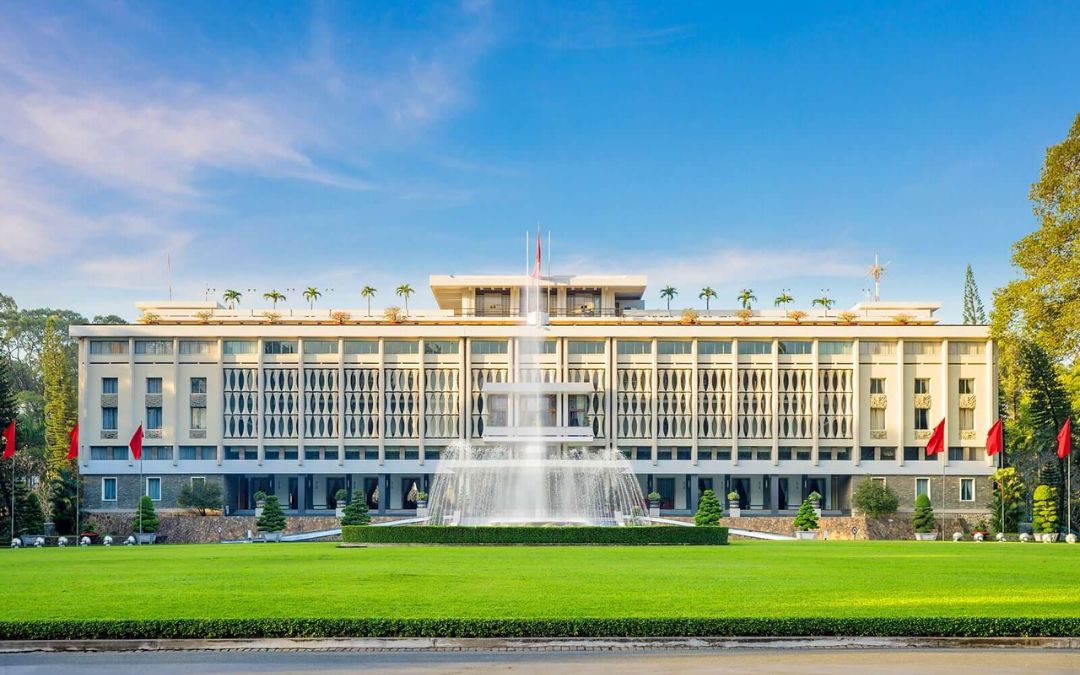
Reunification Palace holds a unique place among Vietnam war locations as the site where the conflict officially ended in 1975.
>> Read More: Lesser-Known Sites For Historical Tours from Ho Chi Minh City
Con Dao Prison
- Location: Nguyen Chi Thanh Street, Con Dao Island, Ba Ria – Vung Tau
On the quiet, windswept shores of Con Dao Island, the walls of Con Dao Prison speak in whispers of endurance and unimaginable pain. Built in 1861 by French colonial rulers and later used by South Vietnam, the prison earned infamy for its “tiger cages”.
These were steel-barred cells so small that prisoners could barely move, dark enough that sunlight was a stranger. Torture, exposure, and squalor defined daily existence, with places like the “cow shed”—a pit beneath animal stalls—designed solely for degradation.
Beyond these grim compounds, the wider island chain housed additional camps, such as Phu Tuong and Phu Binh, where psychological torment often rivaled physical punishment. A short distance away lies Hang Duong Cemetery, where rows of graves, many unmarked, honor those who never left the island alive.
Today, preserved as a site of remembrance, Con Dao Prison stands stark and solemn—its silence urging reflection, its memory reminding visitors why history must never be forgotten.
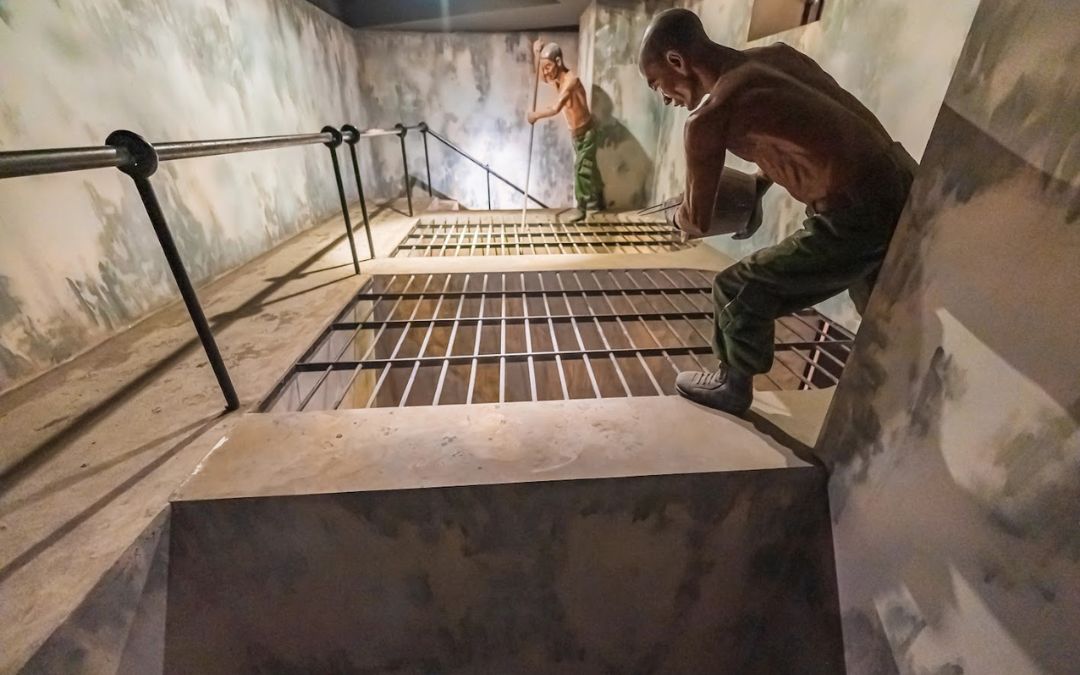
Con Dao Prison represents one of the most haunting Vietnam war locations where tiger cages symbolize the depths of human suffering.
>> Read More: 14 Vietnam Historical Landmarks To Learn About The Country’s Intriguing Past
Practical Travel Etiquette for War Sites
- Dress with quiet respect
Light, modest clothing feels fitting when walking through spaces that carry the weight of history. Covered shoulders and simple attire not only show cultural sensitivity but also match the solemn mood of memorials and museums.
- Listen as if every word matters
Guides often share stories that are deeply personal or drawn from painful collective memory. Paying close attention honors both the speaker and the lives remembered within those walls or grounds.
- Pause and absorb the atmosphere
Many Vietnam war locations are places where silence speaks louder than words. Taking a few moments to stand still—whether in front of a memorial wall or within a dimly lit gallery—helps connect emotionally with what happened there.
- Leave humor outside the gates
Jokes or casual remarks can feel jarring in spaces that commemorate loss. Holding onto a tone of seriousness helps maintain the dignity of the site and respects those who might be visiting with heavy hearts.
- Keep your hands off the exhibits
Artifacts, photographs, and reconstructed scenes are often fragile or irreplaceable. By resisting the urge to touch, visitors help preserve these reminders of history for future generations.
- Think of photos as reflections, not trophies
Capturing an image is fine, but treating the space like a backdrop for playful poses diminishes its meaning. A thoughtful photo of a candlelit altar or a quiet corner tells a story without intruding on the spirit of remembrance.
- Balance the emotional weight with gentle closure
After leaving Vietnam war locations, it can feel grounding to plan something light—a walk by the river, a quiet café visit, or simply time outdoors. This allows space for reflection while easing back into the day with calmness.
Suggested Itinerary to Vietnam War Locations
Day 1 – Ho Chi Minh City Arrival & First Explorations
- Arrive in Ho Chi Minh City (morning or afternoon, depending on your flight).
- Check in to your hotel and take time to rest after the journey.
- Stroll around Dong Khoi Street or Ben Thanh Market to get a first glimpse of the city’s vibrant rhythm.
Day 2 – War History in Ho Chi Minh City
- Visit the War Remnants Museum (morning, 2–3 hours) for powerful exhibits on the Vietnam War’s impact.
- Explore the Reunification Palace (late morning), where North Vietnamese tanks famously ended the war in 1975.
- Wander through Notre Dame Cathedral and Central Post Office (optional, afternoon).
- Enjoy a relaxed evening along Nguyen Hue Walking Street.
Day 3 – Cu Chi Tunnels (Half-Day)
- Depart Ho Chi Minh City early morning for Cu Chi Tunnels (1.5-hour drive).
- Discover the underground network once used by Viet Cong soldiers; crawl through preserved tunnels if you wish.
- Return to Ho Chi Minh City around lunchtime.
- Fly to Hue in the evening (approx. 1 hr 30 min flight, + transfer time to hotel).
Day 4 – Hue & Demilitarized Zone (DMZ)
- Drive from Hue to the DMZ area (about 2–2.5 hours).
- Visit the Hien Luong Bridge over the Ben Hai River, the symbolic dividing line between North and South Vietnam.
- Explore the Vinh Moc Tunnels, where entire villages lived underground to survive bombings.
- Return to Hue in the late afternoon and rest.
Day 5 – Khe Sanh Combat Base & Surroundings
- Head back into the DMZ region (2.5 hours drive from Hue).
- Tour the Khe Sanh Combat Base, once a major U.S. Marine outpost during the Tet Offensive.
- Learn at the museum and walk around remnants of bunkers, airstrips, and exhibits.
- Return to Hue in the evening and prepare for the next day’s travel.
Day 6 – My Lai Memorial (Optional Extension)
- Depart Hue early morning by car for My Lai Memorial in Quang Ngai (around 4–5 hours drive).
- Visit the site of the tragic 1968 massacre, now a memorial and museum.
- Reflect on the village walk, where quiet paths lead to rebuilt homes and commemorative statues.
- Stay overnight in Hoi An or Da Nang (2–3 hours from My Lai), or return to Hue depending on your schedule.
Day 7 – Hanoi War Sites
- Fly early morning from Hue (or Da Nang if extended) to Hanoi (1 hr 15 min flight).
- Visit the Hoa Lo Prison Museum (morning), once nicknamed the “Hanoi Hilton” by American POWs.
- Explore the Vietnam Military History Museum in the afternoon, home to war relics, aircraft, and detailed exhibits.
- End the journey with an evening stroll around Hoan Kiem Lake, reflecting on the week’s historical journey.
Final Words
When planning a journey through Vietnam, it is worth looking beyond the postcard landscapes to the stories etched into its war sites. Vietnam war locations offer insight into resilience, memory, and the human spirit. Experiencing these landmarks side by side with Vietnam’s natural beauty and vibrant daily life reveals a fuller picture of the country—one that is both moving and unforgettable. With thoughtful preparation and the right guidance, such visits can become moments of connection and reflection.
For those ready to explore this side of Vietnam in a way that fits personal interests and pace, let Asia Pioneer Travel design a tailored journey that brings history, culture, and discovery together.
